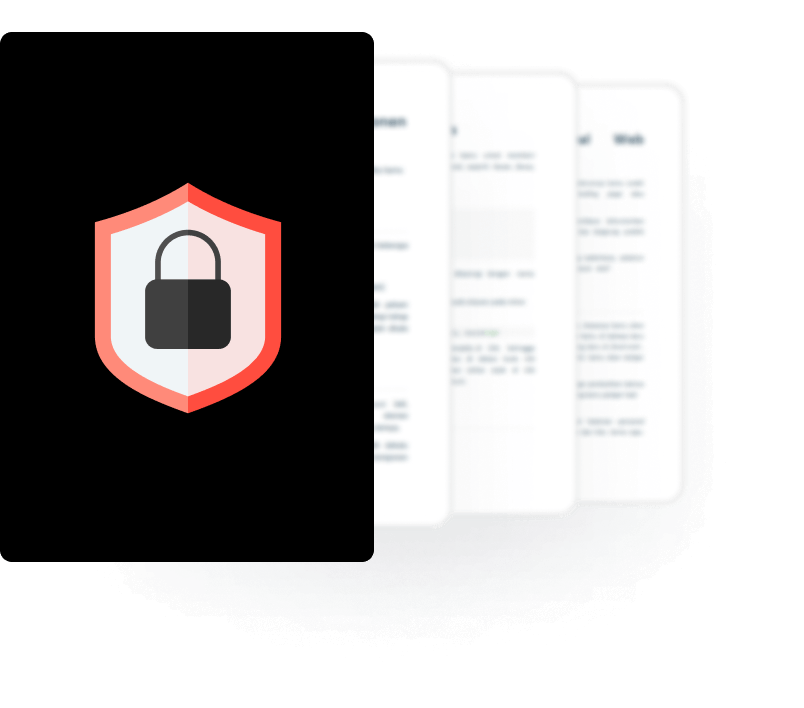
BLOG

BLOG
Mobile Security Framework (MobSF) is a widely used open-source tool designed to help you perform static and dynamic analysis of Android, iOS, and Windows mobile apps. It’s a popular choice among developers and security teams for identifying vulnerabilities early in the development process.
However, as you push for faster development cycles, higher-quality releases, and more integrated workflows, you might find that MobSF doesn’t fully meet your growing needs.
This can become especially noticeable in high-volume environments, where manual configurations and the lack of cloud-native or distributed scanning capabilities are likely to slow down your processes.
MobSF is a starting point, not an enterprise-ready solution. It’s useful for basics but lacks scalability.
Modern mobile security demands go beyond code. Think dynamic testing, real-device analysis, privacy checks, and supply chain scanning, which MobSF doesn’t fully deliver.
Integration matters, big time. CI/CD, IDE, ticketing tool support, and developer-friendly workflows are game-changers for velocity and accuracy.
Compliance isn’t optional (especially in regulated sectors). MobSF lacks the audit reporting and framework mapping enterprises rely on.
Post-sale support ensures long-term success. Open-source means low cost, but also limited guidance. Enterprise-grade alternatives offer onboarding, playbooks, and SLAs.
Appknox combines all the modern protections into one platform. A unified, mobile-first suite with real-device testing, API scanning, privacy oversight, and compliance baked in.
If you're aiming to deploy your apps faster while maintaining quality, you need a solution that can scale with your team’s growth. Here, we share the best MobSF alternatives along with their key features and limitations to help you make an informed decision.
If your organization manages multiple apps or runs frequent builds, MobSF may require additional setup to keep up. It runs as a single-instance tool by default, so when your operations scale, you’ll need to account for the extra overhead in performance and resource management.
Like many other mobile app security testing tools, you might encounter false positives with MobSF, where vulnerabilities are flagged but aren’t actually present. This will eat up your team’s time to validate the findings.
Look for MobSF alternatives that utilize deeper static and dynamic analysis, and consider the context. They’re less likely to mislabel secure code as vulnerable and will allow your team to focus on real threats.
💡Pro tip: Appknox helps you cut through the noise with less than 1% false positives and negatives, so your team can focus on resolving real vulnerabilities instead of wasting time validating false alerts.
MobSF supports automation through APIs, but integrating it into your CI/CD pipelines will likely involve custom scripting and hands-on configuration. If you're aiming for streamlined DevSecOps, this can slow down velocity and create friction across your development and security teams.
MobSF covers native Android, iOS, and Windows apps, which suits many mobile teams. However, if your products are built using hybrid frameworks or rely heavily on backend APIs and cloud services, you may find that additional layers of your architecture aren’t fully accounted for in testing.
As an open-source tool, MobSF relies on community updates. That’s a strength in many ways, but without guaranteed support or a structured update cycle, you will face delays when it comes to fixes or critical feature enhancements.
MobSF includes dynamic analysis, especially for Android, but the setup involves managing emulators and instrumentation manually. This can be resource-intensive and isn't easily automated.
If you’re looking for runtime and risk management insights, choose a MobSF alternative, like Appknox, that runs DAST scans on real devices.
You’ll get detailed, technical reports from MobSF. However, if you require outputs aligned with standards such as OWASP or GDPR, or summaries suitable for regulatory review or board-level reporting, you’ll likely need to invest time in transforming the raw data into business-aligned insights.
If your teams span multiple roles, from developers to security analysts, onboarding can take time. A more intuitive interface could improve adoption and reduce reliance on specialized knowledge within your security function.
| MobSF challenge | Its impact on teams | What MobSF alternatives deliver |
| Limited real-world testing | Emulator scans miss hardware & OS-level threats | Real-device testing that uncovers runtime, API, and environment-specific flaws |
| Manual CI/CD setup | Slows releases with extra scripting & configs | Native CI/CD integrations with GitHub, GitLab, Jenkins, Bitrise, etc. |
| High false positives | Wasted developer cycles on noise, not risk | Context-aware analysis that cuts noise and highlights exploitable issues |
| Compliance blind spots | Basic reports fail audits & delay launches | Audit-ready dashboards aligned to OWASP MASVS, PCI-DSS, HIPAA, GDPR |
| No collaboration workflows | Security stays siloed, slowing remediation | Role-based access & Jira-native workflows for seamless team fixes |
| Community-only support | No SLAs, onboarding, or enterprise guidance | Dedicated support engineers & playbooks for enterprise rollouts |
Suggested read: Why MobSF Isn’t Ideal for Mobile Application Security Testing?
-1.png?width=2996&height=1912&name=Appknox%20(3)-1.png)
Appknox is an end-to-end mobile app security testing platform built to help you find and address vulnerabilities in your Android and iOS apps. It supports static, dynamic, and API testing, providing a comprehensive view of your mobile app’s security posture.
You can run a comprehensive scan in under 60 minutes and receive clear, actionable reports with CVSS scores that anyone on your team can understand.
With less than 1% false positives, you can spend less time validating non-issues and more time fixing what matters. If you’re working in a DevSecOps environment, Appknox fits right into your CI/CD pipeline, making it easy to run security checks without slowing down development.
SAST
Appknox provides simplified, binary-based SAST to scan your application’s APK, AAB, or IPA files without needing source code access. You can get detailed reports in under 60 minutes and even complete static scans in less than 2 minutes.
DAST
Think of Appknox’s DAST scans as putting your app through a real-world security simulation on actual devices, not emulators. You can observe how your app behaves when it runs on real hardware. It mimics real user interactions to uncover threats like insecure data flow, improper session handling, and man-in-the-middle (MitM) attacks.
API security testing
When it comes to testing API security, Appknox makes the process easy and thorough. The platform automatically discovers all the APIs (including shadow APIs) within your app and ensures nothing is overlooked.
You can also customize your security scans to meet your specific needs, such as targeting particular API endpoints, authentication methods, or data payloads, allowing you to focus on the most critical areas of your app.
SBOM analysis
With Appknox’s SBOM Analysis, you get complete visibility into the components powering your software. It identifies third-party libraries and their versions, flagging any vulnerabilities in the mix. This helps you stay on top of security risks, ensuring your software remains compliant with standards like OWASP.
Storeknox
Building on your SBOM efforts, Appknox’s Storeknox takes your app security a step further by continuously monitoring your apps in the app stores.
It helps you detect unauthorized versions, fake apps, and malware, ensuring that only legitimate and secure versions are available for download. Storeknox gives you real-time visibility, protecting your brand and ensuring compliance across all platforms.
Appknox offers flexible, usage-based pricing based on the customer's requirements, with add-ons for manual testing.
Gartner: 4.8/5


QARK (Quick Android Review Kit) is a static analysis tool that helps you uncover security vulnerabilities in your Android applications. QARK thoroughly scans your app’s structure to identify a broad spectrum of issues like inadvertently exported components, poorly protected services, and intents that can be intercepted or eavesdropped on.
By generating Android Debug Bridge (ADB) commands or even full proof-of-concept APKs, it turns potential risks into concrete examples you can test and learn from. The platform also uses multiple decompilers to reverse-engineer your APK more accurately, giving you a clearer picture of how your code behaves.

OWASP ZAP is a DAST tool that gives you a hands-on way to uncover security flaws in your web applications. You can start with active scanning to simulate real attacks using crafted payloads that reveal issues like SQL injection and XSS. Then, let passive scanning inspect your app’s traffic for signs of weak security settings like insecure cookies or missing headers.
To go deeper, use fuzzing to test how your app handles unexpected or malformed inputs, which can expose hidden input validation flaws. If your app relies heavily on JavaScript, AJAX Spidering helps you discover dynamic content and endpoints that traditional crawlers might miss.

Drozer is a dynamic security testing tool built specifically for Android applications. By running an agent on your real device and emulators, Drozer simulates real-world attack scenarios to help you identify vulnerabilities such as insecure inter-process communication (IPC) or unprotected interfaces.
It lets you interact directly with Android app components like Activities, Services, and Content Providers, helping you uncover exposed surfaces and misconfigurations. Drozer is ideal for black-box testing, allowing you to work directly with compiled APKs to identify vulnerabilities.

SonarQube is a static analysis tool that digs deep into both first-party, AI-generated, and third-party code to identify hidden vulnerabilities with fewer false positives. In addition, Taint Analysis tracks the flow of untrusted data across your codebase, helping you pinpoint SQL injection, XSS, SSRF, Deserialization, and other injection vulnerabilities.
If you're looking to prevent data exposure, you can use the platform's secrets detection capabilities to detect exposed secrets like API keys, tokens, passwords, and credentials before they’re ever committed. And with Software Composition Analysis (SCA), you can get a clear view of third-party dependencies, stay on top of license compliance, and generate an SBOM when needed.
|
Tool |
Key features |
Best for |
|
Enterprises looking for a comprehensive, mobile-first security solution with automation and compliance readiness |
|
|
QARK |
|
Developers seeking a free, open-source tool for static analysis of Android apps |
|
OWASP ZAP |
|
Security testers focusing on web application security with customizable scans |
|
Drozer |
|
Penetration testers needing in-depth dynamic analysis of Android apps without source code |
|
SonarQube |
|
Development teams looking for deep static analysis across web and mobile codebases with code quality and compliance features |
MobSF is a powerful open-source tool, particularly for those just starting out with mobile app security. But as your need for speed, automation, and scalability increases, it may no longer be enough on its own.
If you're looking for a more advanced, enterprise-ready solution, Appknox stands out as the best alternative to MobSF. Here's why:
Looking for a scalable, reliable, and DevSecOps-aligned alternative to MobSF?
Appknox can help you future-proof your mobile app security strategy.
Frequently Asked Questions (FAQs)
While MobSF offers initial static and dynamic scanning capabilities, larger teams need real-device testing, AI-powered risk prioritization, and integrated compliance workflows that move beyond MobSF’s foundational functionality.
Alternatives like Appknox offer real-device testing to surface hardware- or OS-specific vulnerabilities, something emulators commonly miss, ensuring more accurate security insights.
Advanced platforms combine contextual SAST/DAST analysis, developer-friendly triage dashboards, and machine learning filtering to cut down noise. As a result, teams spend their time fixing real issues, rather than chasing alerts.
Unlike MobSF's manual API demands, many alternatives offer out-of-the-box integrations with GitHub, Jenkins, Bitbucket, and others, bringing DevSecOps smoothly into everyday workflows.
Enterprise-grade tools generate compliance-ready dashboards and reports aligned with standards such as OWASP MASVS, GDPR, HIPAA, and PCI-DSS—turning security into audit-ready documentation, not an afterthought.
Top MobSF alternatives, such as Appknox, prioritize a developer-centric experience by integrating with IDEs, Jira, and pull request workflows, thereby minimizing training overhead and maintaining velocity across security and development teams.

